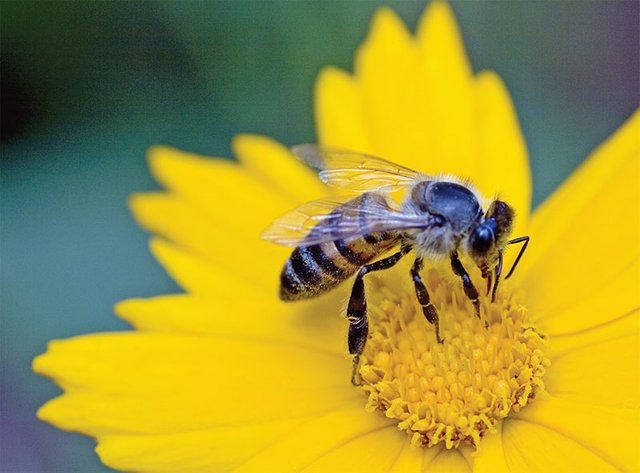Bad news for bees: three-quarters of all honey on Earth has pesticides in it
 About three quarters of all honey worldwide is contaminated with pesticides known to harm bees, according to a new study. Though the pesticide levels were below the limit deemed safe for human consumption, there was still enough insecticide in there to harm pollinators. The finding suggests that, as one of the study authors said, “there’s almost no safe place for a bee to exist.”
About three quarters of all honey worldwide is contaminated with pesticides known to harm bees, according to a new study. Though the pesticide levels were below the limit deemed safe for human consumption, there was still enough insecticide in there to harm pollinators. The finding suggests that, as one of the study authors said, “there’s almost no safe place for a bee to exist.”
Scientists analyzed 198 honey samples from all continents, except Antarctica, for five types of pesticides called neonicotinoids, which are known to harm bees. They found at least one of the five compounds in most samples, with the highest contamination in North America, Asia, and Europe. The results are published today in the journalScience.
Neonicotinoids, or neonics for short, are among the most widely used insecticides in the world. But they’re known to mess with the pollinators’ brains, affecting their ability to learn and remember. That’s a death sentence for bees, which sometimes fly up to seven miles away from their hive to harvest nectar and pollen, and need to remember their way back. By weakening the insects, the chemicals also make them more vulnerable to parasites and diseases, says study co-author Edward Mitchell, the leader of the Laboratory of Soil Biology at the University of Neuchâtel, Switzerland.
These pesticides are partly blamed for the worldwide decline of honeybees, which are key for pollinating crops like apples, berries, cantaloupes, cucumbers, and almonds. More than $15 billion a year in US crops are pollinated by bees. In 2013, the European Union banned the use of three neonics on crops that are visited by bees. But because these pesticides are used to coat the seeds of crops, much of it leaches onto the soil, contaminating nearby wildflowers and other crops. Even in tiny doses, these chemicals can harm bees. “These neonicotinoids are extremely, extremely toxic,” Mitchell tells The Verge, 4 to 5,000 times more toxic than DDT.
To get a better sense of just how widespread neonic contamination is, Mitchell and his colleagues analyzed 198 worldwide honey samples collected as a citizen science project between 2012 and 2016. They found that 75 percent of honey contained at least one of the five tested neonics, and 45 percent of samples had two or more. Honey from North America, Asia, and Europe was most contaminated, while the lowest contamination was in South America. Neonic concentrations were relatively low: on average, 1.8 nanograms per gram in contaminated honey — below the limits set as safe for people by the EU. “For human consumption, we cannot say that there’s any risk based on current legislation,” Mitchell says.
But for pollinators, it’s a different story: negative effects in bees are shown with as little as 0.10 ng/g. So the results suggest that, all over the world, bees are exposed to levels of neonics that damage their brains. He says that neonics were found even in honey from remote areas, like Oceanic islands, where they didn’t expect to see any. One of the honey samples came from a beehive kept in a forest in Neuchâtel surrounded by organic agricultural fields. But event that sample was contaminated. “We were shocked and surprised,” Mitchell says. “There’s contamination everywhere.”
And the problem could be even worse, according to Christopher Connolly, a neurobiologist at the University of Dundee’s School of Medicine, who was not involved in the research. In this study, researchers only tested the honey for five neonics, but crop fields are sometimes sprayed with more than 20 chemicals and bees hop from field to field, Connolly says. So the honey could contain many more pesticides. “This is the tip of the iceberg,” Connolly tells The Verge.
For Mitchell, the only solution to the problem is to change how we raise our crops. “There’s currently a dogma that we can’t feed the world without using these pesticides,” Mitchell says. “But I really question this assumption and I think we should really consider alternatives more seriously than we do today.” Neonics, which kill a broad variety of bugs, are used as preventative — the seeds are coated in these pesticides even though farmers don’t know whether pests are going to attack their crops. Imagine you did that with your body, Mitchell says, taking broad-spectrum antibiotics every day, even though you’re not sick. “No doctor would recommend this, of course,” he says. “It would be completely crazy.” (It is also common practice in most commercial meat operations.)
Connolly says that governments around the world should discourage farmers to use neonics widely, stepping in to help farmers if crops are lost. Some insects are already becoming resistant to neonics, Connolly says, so these pesticides should be used only when they’re actually needed.
Today’s findings are concerning not only for bees. Even though most studies have focused on how neonics harm honeybees, these pesticides are likely to harm many more insects, including butterflies, moths, and earthworms that live in contaminated soil, Connolly says. But our ecosystems need a variety of bugs to be strong and resilient, just as our crops need a variety of pollinators to survive. If we keep using pesticides indiscriminately, “we don’t know when we can expect a tipping point,” Connolly says. “This is a very dangerous strategy for human-kind to go down.”